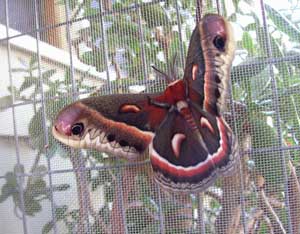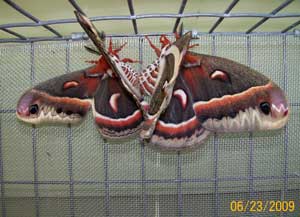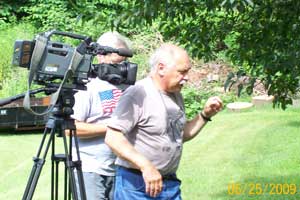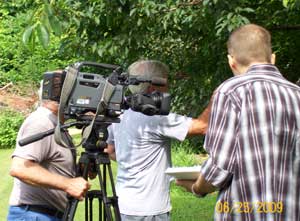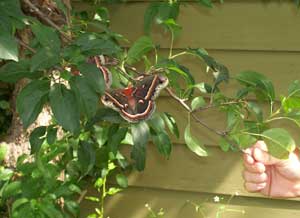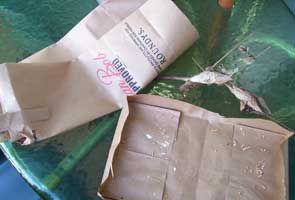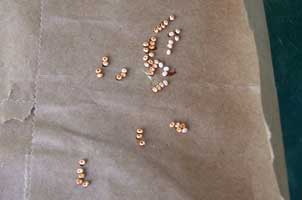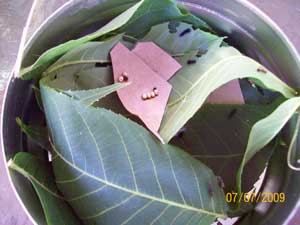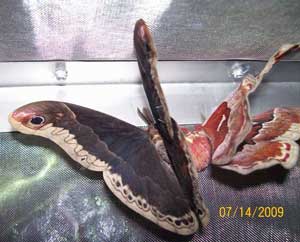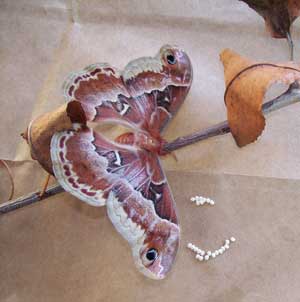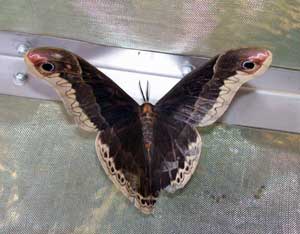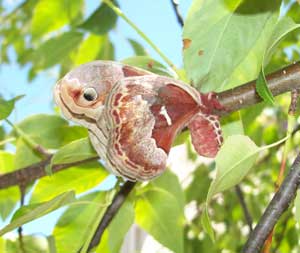Moth Man -- 2009 Season.
... hard to believe I've been doing this for 10 years.
Time line of events of 2009:
- June 20: First Emergence- one male followed closely by 2 more males.
- June 23: First Female - 5 males and one Female so far. Mating pair (already).
- June 24: First Eggs - Female in paper bag over night.
- June 25: First release: 2 males escaped during taping for Wisconsin Gardner episode.
- June 25: Released the female: at twilight. Female had already laid over 200 eggs in the paper bag and started to flutter so I opened the bag and she flew up into the evening sky and disappeared over the neighbor's house.
- June 26: 'Released 3 remaining emerged males: but wait! I left the cage open all night and only one flew away. This is a first. They are healthy and strong and only 2 days old. Plenty old and yet not too old (based on past years). Maybe I haven't sync 'd these guys properly with the 'wild'.
- June 26: By my count I still have 3 cocoons which haven't emerged. These will probably be female. It's not unusual for there to be some lag.
- June 28: Released remaining moths.
- June 30: Female emerges. We'll see if she attracts anyone.
- June 30: Second female emerges.
- July 4: Male moth arrives - attracted by females. He is very battered and seems rather listless.
- July 5: Oldest female has laid her eggs without mating - these will be sterile - and has died. Male moth arrived too late for her.
- July 5: Cut paper bag to split the eggs between bags attached to Walnut and Apple.
- July 6: Younger female is not interested in half-dead male and begins to flutter around in the cage at dusk. Released to fly away.
- July 7: First eggs hatch. Distribute eggs and new larvae to friends who have asked.
- July 13: Prometheus Moth emerges (noticeably smaller than Cecropia).
- July 14: Male Prometheus Moth is attracted in from the wild. Mating commences immediately.
- July 15: Prometheus eggs laid and released male (had another 'date') and female (lay more eggs).
- July 20: Tragedy and Mystery!!! All my Cecropia larvae on the apple tree have disappeared!!! The bags are empty. This has never happened before. Fortunately my Walnut bags still have larvae. There were three earwigs inside the bag. This is my only clue. These insects will eat other insects and I suspect they ate these little larvae.
Pictures and notes from 2009 (click on each image for a larger view):
First Female moth 'chooses' a mate. This mating process can take hours. The female usually draws males to her location using pheromones. The males are extremely sensitive to this and can be drawn from miles away. In this case she had 4 males in the same cage with her so there wasn't much doubt.
A camera crew came to our house to get video of some of the moths for an episode of Wisconsin Gardener (Wisconsin Public Television) to be aired July 23, 2009 @ 7:30 CDT. The host; Shelley Ryan, wants to show people what these amazing insects look like so they won't be concerned (freak out) if they are lucky enough to find them in their gardens.
We placed a couple moths on this apple tree to shoot them in a place they would normally be found in the wild. Two of the moths cooperated and accepted their star status. Two others got bored and decided to fly away. Maybe they got a whiff of something interesting.
We found a cocoon that had over-wintered in the tree. I must have missed it last fall when I took them inside the garage. I usually cut off the twig that contains the cocoon and take it in our unheated garage for the winter. These moths are native to this climate and will survive just fine outside. I only take them in to make sure mice or other small animals don't get into the cocoon and eat the contents.
Here are the two stars of the day (what we're looking at in the previous pictures). One seems to like the bright lights and the other is a little shy and hides behind the leaf (just kidding, of course).
Cecropia moth eggs on paper grocery bag. Bag gives moth plenty of room to move around and lay her eggs. After she laid these I let her go to find a nice place in the wild to finish laying her eggs and die (hopefully in peace).
Cecropia eggs close up (click on image for larger picture). I will cut small groups of these out and send them to people who want to try their hand at raising the larvae. This is very popular with kids and adults alike. They are easy to raise and most are successful. I will place the remaining eggs in large bags made out of netting (nylon window screen) that I tie over branches on trees in the back yard. Most years I only keep eggs from one female (or only the very first from two).
12 Days later the first eggs begin to hatch. Look closely (click on picture to load a larger image) and you can see the larvae eating its way out of the egg (on the paper). The little black larvae have already started to eat (black walnut in this case). These eggs and larvae were 'canned' and distributed to folks who asked.
Promethius moths mating. Note the difference in coloration between the sexes (male on left).
